One of Japan's leading musical instruments, “Wadaiko”, is a must-have item for festivals and events. Despite being known as a historical percussion instrument,
did you know that Japanese drum artists have recently appeared everywhere, and are attracting a lot of attention worldwide?
This article is perfect for those interested in Japanese drums. In addition to exploring the history and types of Japanese drums, we will participate in activities where you can actually play Japanese drums and experience their charm.
Why is the history of “Wadaiko”, indispensable for Japanese festivals?
Wadaiko, is a musical instrument that is familiar to Japanese people. You often see Wadaiko at festivals, but do you know that there is actually a long history for it?
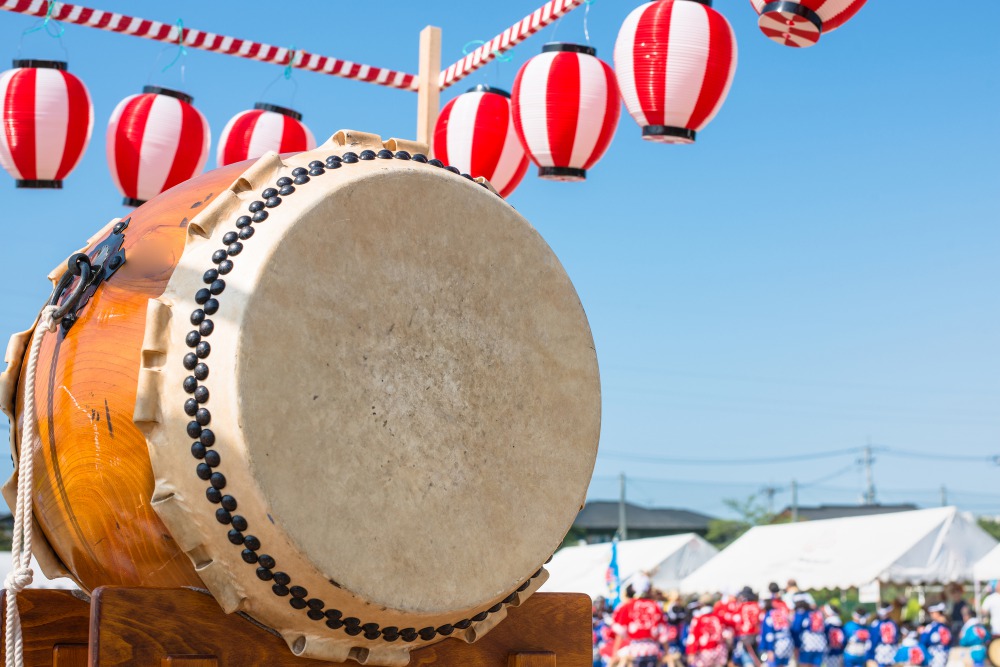
Wadaiko is a big success at the summer festival
The beginning of taiko in Japan, is around 500 BC. In ancient Japan, it was called Tsutsumi, as a general term for membrane instruments. Tsutsumi (Tsudomi / Mamememi) also appears in the Japanese myth “Kojiki”, which is said to have been completed in 712.
Today, it is known as the collective name for traditional drums used in Japan, but there are various theories about the origin of this name. According to one theory, the word “Taiko”, or “Taiku ” from China, came to be called “Taiko” as a collective term for drums used in Japan.

Chinese drums and taikos
This time, we visited the Taiko Museum, “Taikokan of the World” in Taito-ku, Tokyo, and investigated its variety and history.
Dazaikan has a collection of about 800 Taiko drums from around the world including Asia, Africa and Europe, as well as an exhibition of Japanese drums. From the thoughts of Shinnosuke Miyamoto, the 7th generation, who wants to know the quality of the drums by not only learning about the drums, but also by actually playing the drums. Many of the drums on display can be played. You can actually see the differences.

At Taikokan, there are many other drums around the world besides Japanese drums
The oldest drum remaining in Japan
The oldest taiko materials left in Japan, are about 500 years old (around the 6th century) in the late Kofun period. A Minowa (unglazed earthen doll) has been excavated in Minato-cho, Sami-gun, Gunma Prefecture. The Minowa has a barrel- shaped drum that hangs diagonally from the shoulder, and is currently in the Tokyo NationalMuseum.
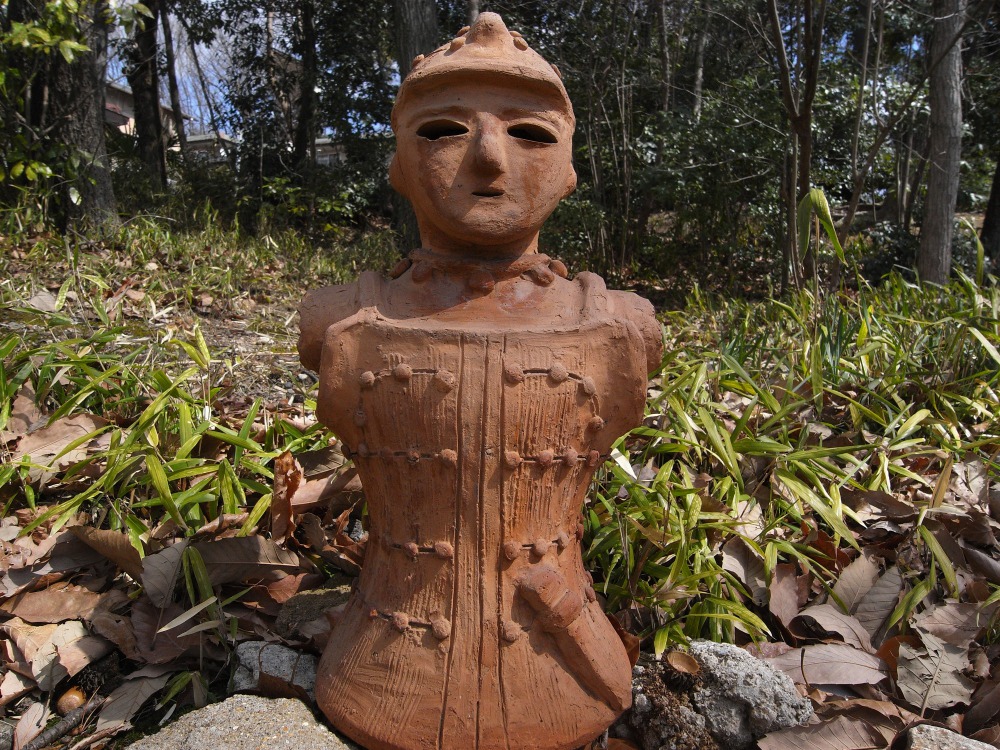
Tenjinyama Kofun Minowa in Gunma Prefecture (image of Minowa with Taiko)
It is now a Japanese drum that is generally used as a musical instrument, but it was once a tool that was closer to the lives of Japanese people. For example: being used to signal warfare and raise morale, and to convey information.
Taiko used in "Gagaku", which has a history of over 1200 years
Japan's oldest classical music “Gagaku” has a history of more than 1200 years. Even now, the Imperial Household Club is handing down the Gagaku. Among such historical music, drums have appeared, like the “Raku Taiko”, which is used for musical milestones and the “San no Tsumumi” rhythm. Gagaku percussion instruments have various sizes and structures, and the ones used vary depending on the event.

Traditional drums and drums still used in gagaku
Nara's “Todaiji Great Buddha Opening Meeting”, held in 752, has a record of exchanging music with other countries. Along with musicians from all over Asia gathering and holding large concerts. You can see that techniques and knowledge from China and Korea have been inherited in Japan and changed into various forms.
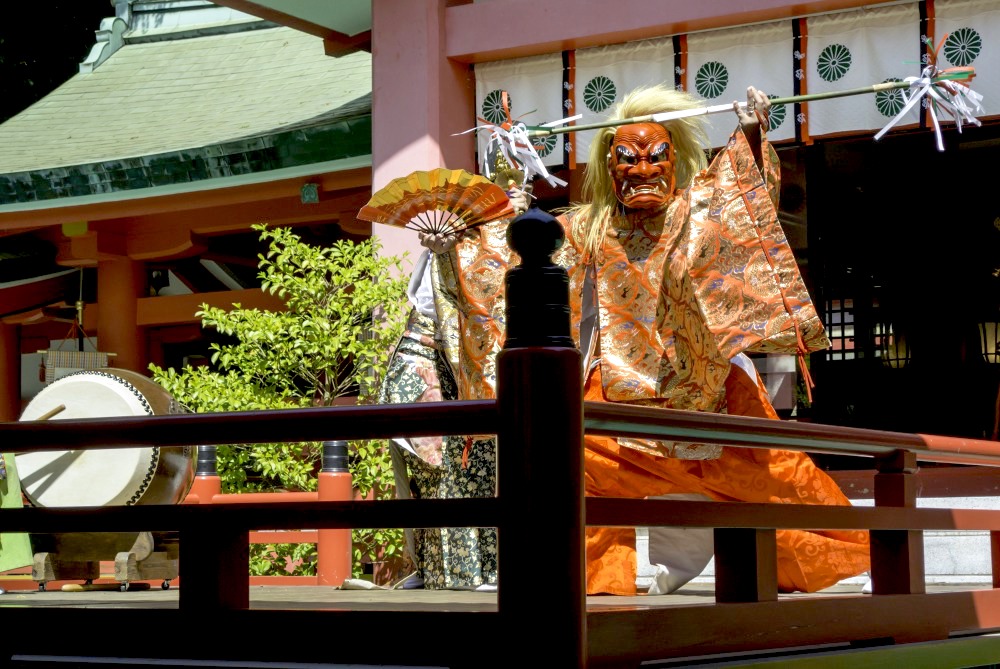
Indispensable for Japanese festivals
By the way, Japanese drums have also appeared in “Noh” and “Kyogen”, which have long been used in Japan, and are still used in theater, adding a touch of performance and dialogue. It takes the role of adding color to the theatre, such as understanding the progress of the song and energizing the dance.

The stage of a playhouse in Uchiko-cho, Ehime Prefecture
Taiko has also been used as an accompaniment music in Kabuki, a popular style among the commoners during the Edo period. Japanese drums are used in various folk performing arts and festivals throughout Japan. You can see that Japanese drums are indispensable in Japanese music and culture.
How to make “Wadaiko” and its types
Wadaiko has been used not only in everyday life, but also in festivals and other events from the courts to the private sectors. There are various types of Japanese drums, from large to small, but there are also features in how to make them.

Kashizume Taiko
Japanese drums are roughly divided into two types, depending on how the skin is laid. The first is called “Kashizume Taiko”, and the body is directly covered with an iron casket. The other type is called “string tightening drums”, which is a method of tightening the drum surface with strings from both sides of the torso.

Chinese drums and frames
Tadashi Taiko is often found in Asian countries such as China, the Korean Peninsula and Japan. Tightening, is the oldest type found in the world. At the Dazaikan, taiko drums from China and South Korea are also exhibited, and there are many parts that look similar, so you can feel the connection unique to the Asian region.

Various types of drums. Many of the drums are made of animal skin
It seems that it is common to use animal skin for the drum surface. Japanese drums use cow and horse skins, while some foreign drums use elephants and giraffe skins.

On the left side is a drum of Vietnamese Ede. The drum has the skin of an elephant. (Taikokan / Taiko Corner in Asia)
[Materials used in Japanese drums] Trumpet: Cowhide, Horseskin
Trunk: wood (claw, plug, tamo, cedar, paulownia, cherry blossom, tochi)
Long drum (Miya Taiko / Da Taiko)
Long drums, which are often used in Japanese summer festivals are Japanese drums; which are also used in shrines and temples, festivals, kabuki and traditional performing arts. It is also used in Japanese drum performances, such as “Kumi Taiko”, which plays in groups with other drums. It uses a drum clamp that is fixed with scissors.
Keyaki is used for the base of the long drum, and large trees cut from the mountain are dried naturally. The raw wood is dried slowly over 3-5 years. It is common to use cowhide for the drum surface. The surface of the torso is carefully finished with a handrail. Since the annual rings are different, experience is required to set them beautifully, all while arranging the grain. Then, the skin is stretched evenly on the finished body, then comes the stroking, the striking and the work of driving down the edge of the skin with a mallet (Enotoshi), which are repeated to stretch the skin evenly. In some cases, adjust the high and low sounds while checking the sound.

A long drum with a large body
Flat drum
“Flat drum” is the same style of drum as the long drum, characterized by its short length and low sound quality. Because it is lightweight and easy to carry, it is used for Awa (dancing around).

A flat drum that is easy to carry
Drum
“Dai Taiko” is also used in the Kabuki theater, and folk performing arts. It is a general term for taikos that are tightened with a string. They can be divided into “rope tightening”, that is tied with a string and, “bolt tightening” ,that is tightened with a flat wheel and a bolt. The difference is that it is easy to adjust the sound and unlink the clasp, but the rope tightening requires elaborate work. Originally, rope tightening such as “Mao” was common, but nowadays itʼs mostly bolt tightening, which is said to have started in the middle of the Taisho era.

Bolt tightening drum
Kaitai drum
“Kaitai drum” is mainly used in festivals in the Hokuriku and Tohoku regions. The drum is not hollow, and doesnʼt have a string attached to the drum. There are various sizes, large and small, and the style of playing from the shoulder is often seen. It features lighter sound quality than a long drum.

An Okedo drum is used in Tohoku festivals and deer dances
Drum
“Tsuzumi” is used in Noh and Nagatoro. This is a drum that is struck by hand, and is a string- tightening drum that puts the skin on the hourglass-shaped torso in the center. There are two types, “small Drum”and “large Drum”, which have the same structure but differ in size and attitude.
A small drum on the right and a large drum on the left. Dazaikan can actually perform (using synthetic leather for substitute)
A small drum and a large drum are often played together, and the performance is an important part of the progress of the song. A delicate instrument whose sound changes depending on temperature and humidity. A large drum is roasted and the surface of the drum is dried before playing, while a small drum needs moderate moisture on the skin. In addition, it will be reassembled each time you play.

Drums used in Japanese classical music
Japanese drum experience that can be easily done in Tokyo!
This time, in order to further explore the appeal of taiko, we have participated in an activity where you can actually play Japanese taiko and play songs.
Nowadays, many people are participating in school club activities and groups organized by local governments, and are enjoying Japanese drums by taking lessons or as a hobby. Wadaiko, which uses the entire body to play sounds, is perfect for light exercises. From here, we will report on the activity.
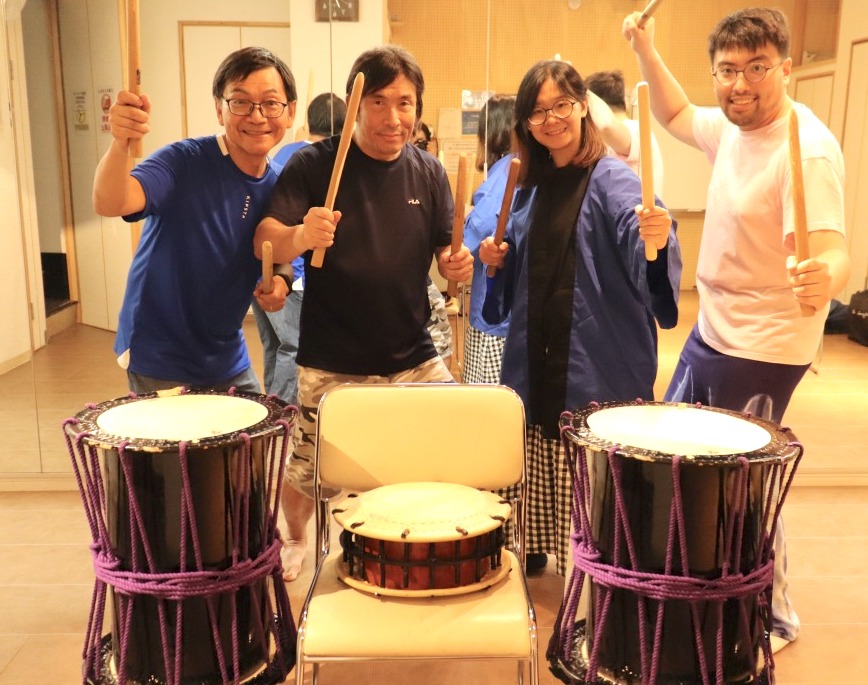
Mr. Hanada and participants of Japanese drum class
This time, I participated in a Japanese drum experience activity of “Wadaiko HANADA” in Okubo, Tokyo. In one, one-hour lesson, you will learn the rhythm of hitting the Japanese drum, and finally all the participants will play the song together.
On this day, we decided to have a Japanese drum experience with three participants who were traveling from Hong Kong. All three are curious about Japanese drums. Wadaiko HANADA seems to have students from overseas, and there are many participants from countries such as Australia, Singapore and the United States. I'm surprised that they not only play Japanese drums, but also have international exchanges. You can see the high degree of attention from overseas.
Hanada-san, who runs a Japanese drum class in Shinjuku and Iwata, gives guidance. He / she teaches kindly to beginners and is very friendly. Wadaiko has no scale, unlike other instruments, so the knack for staying on beat is very useful. Although it is difficult to perform beautifully with strong and weak sounds, it is easy to play, so even beginners can easily try it. All the members who participated this time were beginners. Listen carefully to Hanada's explanation of drums.

Hanada-san provides solid support
The Japanese drums used in the lesson are a small drum, featuring a light sound and a tightening drum featuring a high treble. Using a basic beat, I begin to beat slowly with Hanada's signal.
By mimicking Hanada's rhythm and playing the drums, each participant has their own personality, such as being too worried about the timing and not being able to move their hand as expected, or not being able to grasp the tempo. It was very difficult to learn the rhythm, and there were times where we struggled. Not only Hanada-san, but also the participants will give advice to each other and learn happily.

Drum and Taiko drums used in activities
Now that you've learned how to play a drum, you can practice dividing a song into multiple parts and finally play it through. In this experience, we will bring out the beauty of the taiko drums, based on the rhythm.
In order to play one song through, it is necessary to carve the rhythm into the body while being conscious of the connection of each part. By repeatedly playing a song over and over, and listening to the surrounding sounds, everyone's timing gradually became appropriate.

Participants who learn the rhythm of Japanese drums
A Japanese drum without a scale cannot play a melody, but a great piece of music can be made by using the drum volume and sound quality together. Finally, when all the participants are in rhythm, there is a sense of accomplishment and pride. Although the language was different, I was able to interact with my heart through rhythm.
Japanese drum group “DRUM TAO” attracting worldwide attention
Not only are there many Japanese drum classes in Tokyo, but the famous Japanese drum group has performed all over the world, as well as in Japan. Lastly, we will introduce “DRUM TAO”, a group that plays masterpieces with sophisticated visuals and performances, which are driving the recent Japanese drum boom.

Performance that overturns the image of traditional Japanese drums CDRUM TAO
“DRUM TAO”, is a Japanese drum group that is popular not only in Japan, but also from around the world. It is expected to become even more popular in the future with the achievements of receiving the “6th Tourism Agency Commendation Award” and “70th Anniversary of the Minister of Internal Affairs and Communications Commendation for the Local Autonomy Law” from the government.
Wadaiko “DRUM TAO”, which has been actively featured in the media, including in the NHK Red and White Song Battle at the end of 2018. Currently, there are over 700 performances every year, including in Japan. During the world tour, he had many trial and errors, updating the technology and production. Breaking down the concept of traditional Japanese drums, we are constantly evolving with new collaborations such as working with top artists and the introduction of projection mapping.
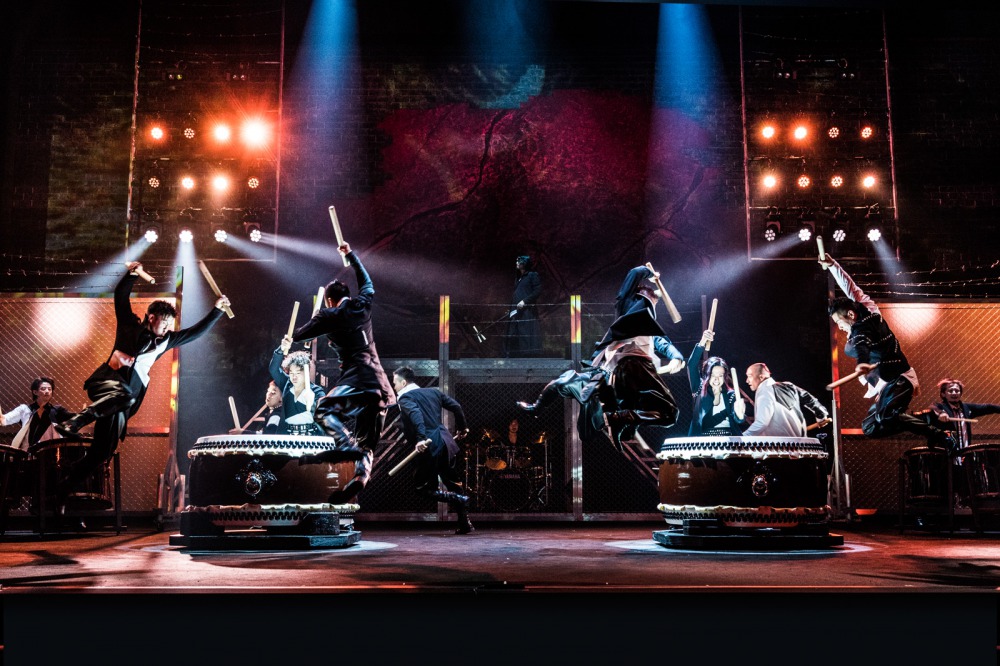
Overwhelmed the audience on a dynamic stage CDRUM TAO
The group, which began in 1993, consists of more than 40 members. Overcoming the classic image of traditional Japanese drums, the performance that is brought out in a modern and stylish manner is an amazing sight.
Another feature is that the costumes are also designed to stick out and charm us. You can see the attention to detail, such as requesting designer Junko Koshino to design costumes, and make new ones for each performance. The body beauty of DRUM TAO members is also popular. The body of a member trained like an athlete gives a sense of unity through performance, and you can fully enjoy the production not only in your ears but also with your eyes.
The performance of “DRUM TAO”, where you can enjoy Japanese drums as well as Japanese musical instruments such as: whistle, koto and sword. Itʼs perfect for those who want to enjoy powerful performances.
You can see part of the performance on Youtube. >>Click here for DRUM TAO video
How about trying the most popular Japanese drums in the world?
Wadaiko, an instrument that everyone feels familiar with. In addition to enjoying Japanese drums as a musical instrument, “Wadaiko HANADA” introduced us this time, while you can enjoy interacting with other participants. You can communicate with your friends through rhythm. Wadaiko has no musical scale and can be easily challenged by just learning the rhythm, so you can play happily regardless of age or nationality. Why don't you join the Taiko experience as a new hobby?











_600x400.jpg)














_600x400.jpg)


